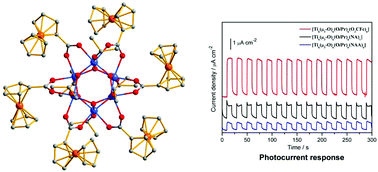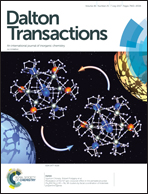A ferrocenecarboxylate-functionalized titanium-oxo-cluster: the ferrocene wheel as a sensitizer for photocurrent response†
Abstract
Sensitized titanium-oxo clusters (TOCs) have attracted growing interest. However, reports on TOCs incorporated with a metal complex as photosensitizers are still very rare. In the present work, the organometallic complex ferrocene was used as a sensitizer for a titanium-oxo cluster. A ferrocenecarboxylate-substituted titanium-oxo cluster [Ti6(μ3-O)6(OiPr)6(O2CFc)6] (Fc = ferrocenyl) was synthesized and structurally characterized, in which the ferrocene wheel performs as a sensitizer for photocurrent response. For comparison, naphthalene-sensitized titanium-oxo clusters [Ti6(μ3-O)6(OiPr)6(NA)6] (NA = 1-naphthoate) and [Ti6(μ3-O)6(OiPr)6(NAA)6] (NAA = 1-naphthylacetate) with the same {Ti6} core structure were also synthesized. The structures, optical behaviors, electronic states and photoelectrochemical properties of these sensitized {Ti6} clusters were investigated. It is demonstrated that the introduction of ferrocene groups into the titanium-oxo cluster significantly reduces the band gap and enhances the photocurrent response in comparison with the naphthalene-sensitized clusters. The substantially reduced band gap of the ferrocene-sensitized cluster was attributed to the introduction of Fe(II) d–d transitions and the possible contribution from the Fc → {Ti6} charge transfer. For the naphthalene-sensitized clusters, the better electronic coupling between the dye and the {Ti6} core in the 1-naphthoate (NA) substituted cluster results in higher photoelectrochemical activity.



 Please wait while we load your content...
Please wait while we load your content...